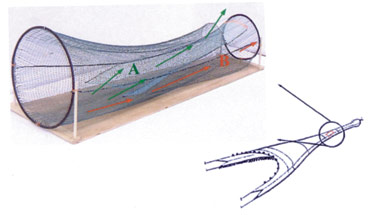| 2003 |

|
YEAR BOOK |
Bord Iascaigh Mhara
|
Protecting spawning cod in the Irish Sea
through the use of inclined separator panels
in Nephrops trawls
|

Since these trials, experimentation has been carried out with the inclined separator panel in the Nephrops fisheries in the Celtic Sea off the South-west coast of Ireland, and also the important Nephrops fishery on the west coast at the back of the Aran Islands off Galway. Again the results have shown the potential advantages as a conservation device, and subsequently four skippers from ports in the South-west have now voluntarily fitted panels as a means not only to reduce the level of juvenile fish retained but also with the objective of improving the fish quality by separating delicate fish such as whiting, haddock and hake from Nephrops into a top codend placed over the escape hole to retain the catch of fish. This codend is constructed in large mesh size, so only marketable fish are caught.
The success of the panel is attributed to its design and its positioning within the trawl. It has been suggested that the good separation of cod may be because of their behaviour of staying close to the seabed after encountering the footrope at the mouth of the trawl. This becomes less pronounced further back in the trawl, and therefore a higher proportion would swim above the panel, which is positioned in front of the codend. It has the advantage of being inexpensive and relatively easy to install and maintain. The initial rationale behind its development was that Nephrops fishermen would gain access to fishing grounds otherwise closed, without catching quantities of spawning cod - i.e. an incentive to fish more responsibly instead of total exclusion. The data from the trials with the separator panel have demonstrated that the use of the panel meets these requirements, and thus the main aim of releasing spawning cod in this case has been achieved.
The Irish Sea cod closure has now been in place for four years, in three of which the use of the inclined separator panel has been permitted. Fishermen throughout Ireland claim that in fact the closure has worked, and this has been reflected in increases in the number of spawning cod seen in recent stock assessments. How much of the recovery in the stock is due directly to the use of the separator panel is unclear, but there is no doubt that it and other such devices have an important role to play in future fisheries management policies and are much more palatable to fishermen than the use of measures that restrict fishing effort, such as limitations on the number of days allowed to fish.
Contact: D.J. Rihan, An Bord Iascaigh Mhara, PO Box 12, Crofton Road, Dun Laogahire, Co. Dublin;
Tel: +353 1 2144104; Fax: +353 1 2300564; E-mail: [email protected]